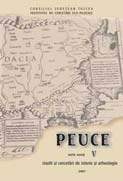Pipe de lut descoperite la Babadag
Clay tobacco pipes discovered at Babadag
Author(s): Adina Ignat, Iuliana Costea (Zvînca), Aurel StănicăSubject(s): Archaeology
Published by: Institutul de Cercetari Eco-Muzeale Tulcea - Institutul de Istorie si Arheologie
Keywords: Clay tobacco pipes; Turkish pipes; monogram seals; bird seals; Babadag; pipe din lut; pipe turceşti; ştampile; monograme arabe
Summary/Abstract: This study presents a typology of clay tobacco pipes which were discovered in Babadag, in the area of Mosque Ali-Gaza. The archaeological survey excavations praise a building that was constructing probably at the beginning of the 17th century. Among other archaeological materials recovered, we noticed a number of 215 clay pipes. From a typological point of view, the clay pipes are differentiating depending on bowl's dimension, form and type of decoration. For the classification it was used as a specific feature bowl's shape and pipes were divided in three groups. First group include pipes with rounded bowl, the second include pipes with the bowl in disk form and the third lily-shaped pipes, as R. Robinson used or bell-shaped pipes, as M. Stančeva used. Each group have types and variants depending on the form, decoration and dimension. Clay pipes from Babadag were made in two-part moulds of stone or metal; majority of them, after the application of an undercoat, were decorated and marked with the monogram signature seal, other have bird seal. The most frequent decoration's motifs are floral and geometrical one: palmettes, rayed dots, reverse – S, lozenge, line of larger rouletting like a zipper etc. Pipes from Babadag are set in the chronological frame in the 17th – 19th century.
Journal: Peuce (Serie Nouă) - Studii şi cercetari de istorie şi arheologie
- Issue Year: V/2007
- Issue No: 5
- Page Range: 335-362
- Page Count: 28
- Language: Romanian

